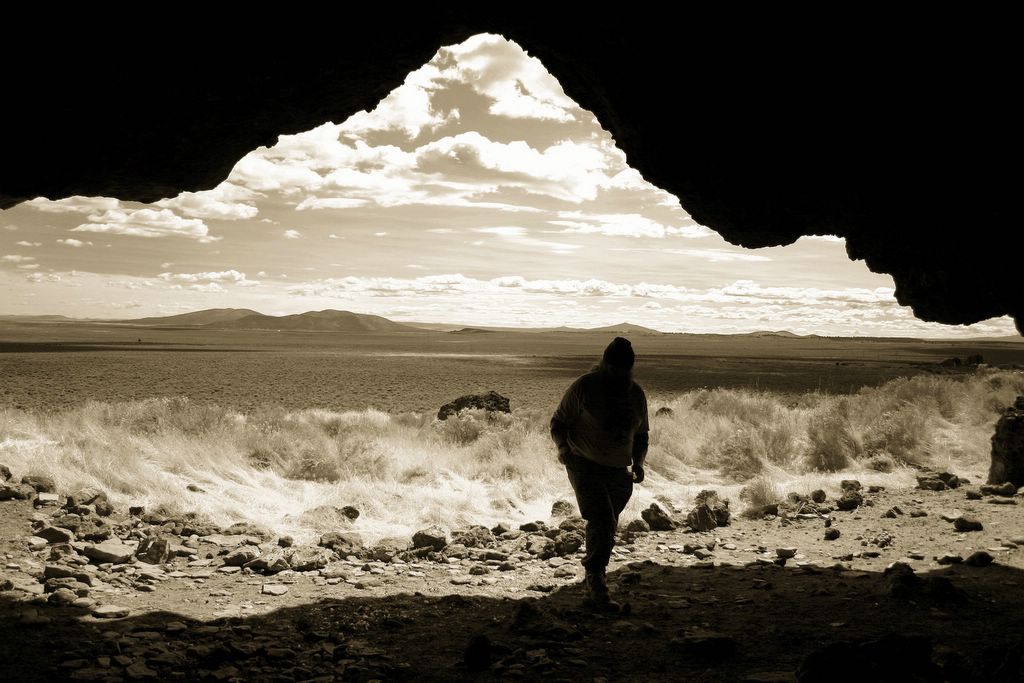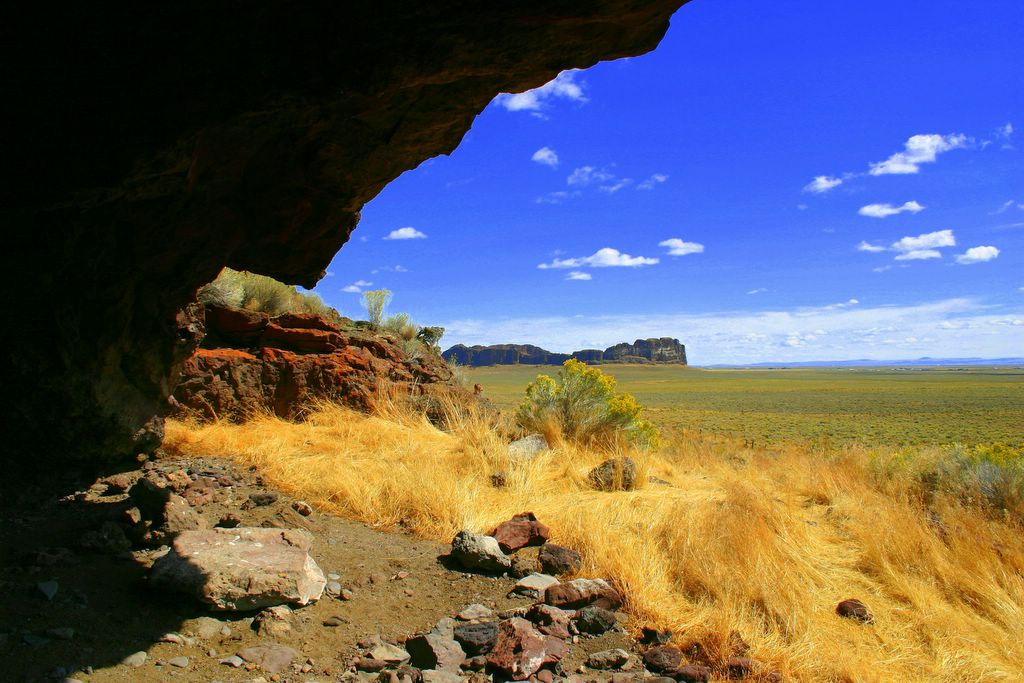Fort Rock Cave
 © Punkin Dunkin Productions
© Punkin Dunkin ProductionsI have returned from an overnight trip to SE Oregon with my geography class. We visited Fort Rock (near Paisley, Oregon)and the famous "sandal cave" where sagebrush sandals dating back to 9,000 years ago were excavated in the 1930's.
 Of course, these are a replica of what was found. But apparently I made a big boo-boo while at the cave. The site is not only revered by Native Americans, but it is also on the National Heritage Site list. We were asked not to disturb anything on site and to treat the area with much respect. I did so, feeling a deep sense of sacredness and spirituality while I photographed the area (it was that similar feeling of humbleness that came over me when I visited the reception hall of the Milwaukee Art Museum). Half an hour into the guided tour and I was poking around in the dirt and rocks. I happened to find a large piece of obsidian rock (when I say large, I'm only talking 2-3 inches long).
Of course, these are a replica of what was found. But apparently I made a big boo-boo while at the cave. The site is not only revered by Native Americans, but it is also on the National Heritage Site list. We were asked not to disturb anything on site and to treat the area with much respect. I did so, feeling a deep sense of sacredness and spirituality while I photographed the area (it was that similar feeling of humbleness that came over me when I visited the reception hall of the Milwaukee Art Museum). Half an hour into the guided tour and I was poking around in the dirt and rocks. I happened to find a large piece of obsidian rock (when I say large, I'm only talking 2-3 inches long). I picked it up and dusted it off. I didn't even have to dig it out of the ground; it was simply just resting on top of some other rocks. I showed it to the professor and got a rather stern look in return. Other people were sitting, standing, rocking back and forth on and poking around the rocks and boulders. But I happen to find a unique rock and I'm the bad guy. Go figure. I know that it's illegal to remove such items from historic sites. I had no intention of doing so, less that I take some sort of bad karma with me. I simply found the rock to be appealing enough to touch.
I picked it up and dusted it off. I didn't even have to dig it out of the ground; it was simply just resting on top of some other rocks. I showed it to the professor and got a rather stern look in return. Other people were sitting, standing, rocking back and forth on and poking around the rocks and boulders. But I happen to find a unique rock and I'm the bad guy. Go figure. I know that it's illegal to remove such items from historic sites. I had no intention of doing so, less that I take some sort of bad karma with me. I simply found the rock to be appealing enough to touch.
7 Comments:
That bottom shot is gorgeous!
hee hee, ghost dog likes your butt.
seriously though, i think it's a disservice not to touch the rock. who says it can't be touched? and revered? i mean i know who says that, but please, this is part of our earth. "our," being a collective "our."
D'oh!!
I meant the last picture...the one on the bottom. I mean, not on your bottom...the one at the bottom of the post...oh, phooey.
Lemme get my foot out of my mouth. Good thing my shoes are new and I haven't worn them in the back yard...
It's okay ghost dog. My butt takes it as a compliment even if you weren't talking about her.
I know it was just a rock. I mean they've got horse dung and nasty packrat middens in the cave. How sacred of site is it really if the upkeep is a bit slow?
Sheepishly, I admit that I snagged some obsidian rocks from another cave (no, not on any historical site- unless an ATV trail and ancient beer cans are a indication of a sacred place). But these little rocks were less than an inch long. I plan to use them in a very respectful and thoughtful way.
:D Anything involving tushies should be thoughtful and respectful.
My own bad:
Last Sunday, climbing Camelback, I came across two highly polished stones looking very out-of-place on the rugged, dusty mountain. Someone had clearly left them behind on that small outcropping just off the path. On the back of one of them, you could just make out "Guillermo." Upon discovering someone's tiny legacy, I did the unthinkable: I stole Guillermo the rock.
I don't know why those rocks were left behind, but they struck me as traveling rocks in need of adventures. I'm going to take them hiking somewhere cool and leave them for someone else to discover.
I think that's okay.
-L
All butt comments aside, wanted to say that the framing of these scenes with the upper edge of the cave opening is pretty durn wicked. Rock on, Cos.
-L
Most archaeological sites have not yet been discovered, and most are destroyed before anyone can stop it. If the obsidian object photographed is what you are referring to, then you seem to have indeed located an obsidian artifact, although it was on the surface and, more likely than not, had been previously disturbed by people or rodents. It is a typical blade-like tool. Archaeologists recommend that one leave an artifact where it was if one had no way of recording its location. You know better than to attempt excavation. All you would need to collect valid data would be your camera, a compass, ruler, and tape measure. Photograph these instruments with the object, and be sure to show the proximal relationship between the tape measure and a fixed datum; photograph as many permanent reference points as possible. It is, as you said, typical, and artifacts are often found abundantly in contexts analogous to dumps (midden - ancient landfills). Since accessible caves rarely do not contain artifacts, you may have made some potentially important discoveries! Obsidian can be dated (hydration rims - water absorption at the surface of obsidian over time tends to be regular in regard to the context of deposition [soils, etc.]and to specific obsidian sources - all chemically distinct [the composition is that of its crystalline igneous source material]). If you are interested, Many laboratories can perform non-destructive analysis of obsidian, which establishes relative age and formation (there is a Dairy, Oregon source) for a nominal fee (usually around $30 per specimen at Berkeley XRF labs ). A handheld GPS is a great tool to have if you plan on collecting material in the future. I suggest you try to remember and record exactly where these caves were and endeavor complete Archaeological site forms on any isolated obsidian fragments or other artifacts you may have or have already picked up. It may surprise you haow common and diverse stone artifacts can be, from ground objects identical to river cobbles in nearly every way except for the presence of submacrosopic surface striations (my neigborhood was built on a site having plentiful deposits of this kind in conjunction with more diagnostic, recognizable forms - these artifacts are everywhere here and it is a fucking shame that I am the only person who cared sufficiently to report it - developers hate archaeology and I hate developers) to flaked bottle glass (who notices?). Education makes a total difference in regard to the identification and protection of threatened animal and plant life and cultural materials. Contact me if you have any questions. ... outstanding photos, by the way.
-Thaddeus
endophasy@yahoo.com
Post a Comment
<< Home